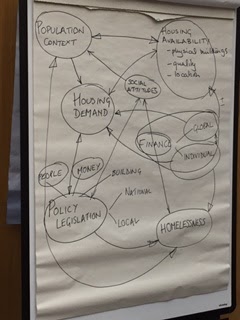Here Nick Bland, co-director of What Works Scotland, explains more about purpose of the event and what participants learned.
The workshop was intended to help participants:
- Consider the role of formal and informal institutions in society in maintaining inequality
- Understand what a ‘systems thinking’ approach is, and how it can contribute to public service reform
- Learn how to apply a systems 'mindset' to deepen the understanding of their local systems
- Start to think about how best to intervene in their local systems
John Amis, Professor of Strategic Management & Organisation at the University of Edinburgh Business School, spoke about Institutions & Inequality: Understanding the Persistence of Inequality.
While there has recently been a proliferation on research exploring the antecedents and consequences of inequality, comparatively little work has examined the ways in which societal institutions create a context for the perpetuation of inequality.
John offered insights about how activities and practices become established as routine and taken-for-granted ('institutionalised') in such a way as to make the persistence of inequality seem inevitable. Inequality is further supported, reinforced, and justified by language that is used in organisations and wider society.
Allan Best, Managing Director, InSource Research Group from British Columbia in Canada spoke about Doing the dance of system change.
Complex problems require complex solutions. In his presentation, Allan built a bridge between how best to understand the complex problem of inequality and systems thinking as a lens for developing comprehensive, integrated strategy.
Systems thinking emphasises the importance of the dynamic inter-relationships between public services rather than thinking about them as static, separate units. This demands continuous learning and adaptation.
To implement complex strategy, it needs diverse partner organisations to weave their different mandates and roles together: learning how to do 'the dance' to achieve meaningful system change.
Allan explained key differences between complex and simpler systems, using a case study of a project to develop a framework for equity in healthcare provision in Canada. This identified five simple rules for system change:
- Fostering strong leadership
- Cultivating champions
- Developing networks and partnerships
- Learning from and building upon successful equity-related initiatives
- Using continuous improvement processes
 |
| The causal loop mapping exercise |
Pam Dawson, the National Co-Ordinator of the Lloyds TSB Foundation’s Place-based Programme, said
"The seminar was invaluable for me. John’s session on institutions and inequalities helped me understand why we still have inequality, and how institutional thinking continues to ensure that power remains in the hands of the few.
"Allan's session on 'doing the dance of change' was so great in helping to shape my thinking on how you can work within complex systems and create change. Hearing about different examples of where these systems have been changed was exciting.
"Communities face many challenges due to the systems in place and the seminar provided an opportunity to network with others working in this way, learn what has worked and not worked, and start new conversations."
The workshop took place in June at the Grassmarket Centre in Edinburgh.
Download the presentations and documents from the What Works Scotland website
- John Amis, Institutions & Inequality: Understanding the Persistence of Inequality (PDF)
- Allan Best, Doing the dance of system change (PDF)
- Systems change self-assessment tool (PDF)
Share your thoughts
Were you at the workshop? Have you used the ideas and strategies in your work since then? Or do you have questions?
Please comment. Or you can contact Nick directly.

No comments:
Post a Comment
Note: only a member of this blog may post a comment.